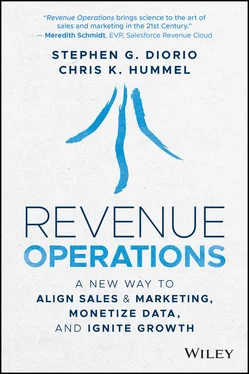Stephen Diorio - Revenue Operations
Здесь есть возможность читать онлайн «Stephen Diorio - Revenue Operations» — ознакомительный отрывок электронной книги совершенно бесплатно, а после прочтения отрывка купить полную версию. В некоторых случаях можно слушать аудио, скачать через торрент в формате fb2 и присутствует краткое содержание. Жанр: unrecognised, на английском языке. Описание произведения, (предисловие) а так же отзывы посетителей доступны на портале библиотеки ЛибКат.
- Название:Revenue Operations
- Автор:
- Жанр:
- Год:неизвестен
- ISBN:нет данных
- Рейтинг книги:3 / 5. Голосов: 1
-
Избранное:Добавить в избранное
- Отзывы:
-
Ваша оценка:
- 60
- 1
- 2
- 3
- 4
- 5
Revenue Operations: краткое содержание, описание и аннотация
Предлагаем к чтению аннотацию, описание, краткое содержание или предисловие (зависит от того, что написал сам автор книги «Revenue Operations»). Если вы не нашли необходимую информацию о книге — напишите в комментариях, мы постараемся отыскать её.
Revenue Operations: A New Way to Align Sales and Marketing, Monetize Data, and Ignite Growth
Revenue Operations
Revenue Operations
Revenue Operations — читать онлайн ознакомительный отрывок
Ниже представлен текст книги, разбитый по страницам. Система сохранения места последней прочитанной страницы, позволяет с удобством читать онлайн бесплатно книгу «Revenue Operations», без необходимости каждый раз заново искать на чём Вы остановились. Поставьте закладку, и сможете в любой момент перейти на страницу, на которой закончили чтение.
Интервал:
Закладка:
The pivot to 4D selling has changed the economics and the architecture of selling. The massive and continued shift to remote work, hybrid work, and work-from-anywhere practices by both buyers and sellers has made digital, data-driven, dynamic, and dispersed selling teams a primary channel to market. This has changed the economics of field sales by shifting dollars from travel and real estate to more scalable training and technology investments. It has also significantly altered long-standing assumptions about sales force emphasis, roles, workloads, selling costs, and the mix, nature, and cadence of engagement needed to convert prospects into customers. This has every organization rethinking geographic-based territory definitions, quota assignments based on face-to-face calling patterns, and labor-intensive coverage models. Readjusting the “architecture” of your commercial model to reflect these new dynamics can reduce selling costs and improve seller performance significantly with no additional investment.
Managing customer lifetime value has become a primary focus as businesses chase recurring revenues. A business with recurring revenues is worth more than one that must sell their offerings to their customers one at a time repeatedly. So it's no surprise that most boards (53%) are pushing their CEOs to repackage their products and services as subscription pricing models, usage-based models, or cloud-based offerings, according to a report by CFO Magazine. 50Almost every business (90%) that sells “on-premises” technology, equipment, or software is moving to a cloud model, according to Gartner. 17Any business that can pull it off – including industrial firms like Honeywell, automotive firms like Audi, and infrastructure like Flexential – is trying to move to recurring revenues. Moving from selling products to selling subscriptions and SaaS solutions requires significant changes to the way you “go to market.” It shifts the focus of selling from hunting for new customers to building more loyal customers and expanding relationships with them. It has increased the importance of growing customer equity and lifetime value as a driver of firm value. It has also forced organizations that engage customers – sales, marketing, customer experience, and support services – to find ways to work together collectively as one revenue team.
Growth has become a team sport. There are 18 strategic levers that grow revenues, profits, and firm value, according to academic research compiled by the Marketing Accountability Standards Board. 7These growth levers reside in different parts of your organization. They include the ability of IT to move information quickly, the ability of service teams to build customer equity, and the ability to deliver a superior digital channel experience. They also include the effectiveness of sales and marketing channels, the engagement of customer-facing employees, and the perceptions of innovation that your product team creates in the marketplace. No single organization or leader controls all 18 of these growth levers. Our analysis shows they are distributed across sales, marketing, customers success, product management, and sometimes information technology. When we add it up, none of these traditional job functions controlled more than a quarter of the levers of growth. And critical new pieces of the growth equation – such as customer analytics and managing digital channels – are being fought over by these executives. As a result, teamwork across functions has become fundamental to managing revenue growth. This is forcing managers to develop operating models, incentives, and platforms that help get marketing, sales, and service silos working as one revenue team with a single common purpose.
A growing focus on financial accountability has made it more difficult to fund smart growth investments. Growth leaders – CMOs, CROs, and Chief Commercial Officers – are under growing pressure to prove the contribution of growth investments and assets to financial performance. This is a good thing. You can't manage what you cannot measure. Demanding to know the financial contribution of every growth action and investment to the business is essential to generating profitable growth. This focus on increased financial accountability is fundamentally changing how commercial resources and assets are allocated, organized, funded, measured, and deployed. But there's a problem. The way most organizations measure and calculate the performance of their growth investments is flawed. Simple revenue attribution measures favor short-term actions. Smart investments that connect sales to marketing and span budgets are hard to justify. Valuable capital investments like building the type of digital selling infrastructure that has made Amazon preferred by most shoppers don't fit into operating budgets. They also take too long to pay off for impatient CFOs. This has created unintended consequences that actually do more harm than good. For example, a bad short-term investment with clear attribution will take precedence over a profitable long-term investment that requires many different organizations to work together. This flawed approach to financial accountability has made it next to impossible for managers to create a business case for investments that can create scalable growth, such as one-to-one personalization, real-time coaching, response management, and account-based marketing.
The Challenge of Managing 4D Selling Systems
How Digitally Enabled, Data-Driven, Dynamic, and Geographically Dispersed Revenue Teams Are Changing the Way We Manage Selling Systems
A massive shift to work at home, hybrid work, and work from anywhere policies will act as a tipping point for sales transformation and dramatically alter the sales and marketing mix. Budgets are shifting to digital, data-driven, and measurable channels that accelerate the digital transformation of sales.
Remote selling is the “new normal” as the coronavirus pandemic forced over 4 billion consumers, customers, employees, and salespeople to work, sell, and buy from home. The dramatic displacement of revenue teams forced businesses to accelerate their transformation to a more digital selling model to adapt to remote selling and a new buying reality. Lost in the rush to enable remote selling is the fact that virtual selling channels offer growth-oriented companies the potential to transform sales performance and accelerate growth.
The shift to remote buying is having an even bigger impact as customers demand a faster cadence, more complete answers, and more personalized content at every stage of the customer journey – regardless of whether they are talking to an account rep, Business Development Reps (BDRs) product specialist, or customer service manager. “As B2B buyers' increasingly use digital channels and information in the customer journey, it is reshaping how B2B sellers engage with them,” according to Brent Adamson, Distinguished VP, Advisory, Gartner. 160“This presents a huge challenge to B2B revenue teams because our research tells us that most B2B buyers under the age of forty would prefer not to talk to sales and service reps at all, if it were possible, and they can see no difference in the digital buying experiences of most of the companies they try to buy from. It is going to be mission critical for reps to make the most of the moments that matter during this buying cycle.” That means building buyer empathy, sharing more compelling content, asking smarter questions, and having conversations that build trust, communicate the financial value of their solutions, and reveal the nuanced differences between their competitors.
The shift has changed the ways businesses sell to customers by:
1 Redefining field selling economics and capital investment. From a sales perspective, sales executives have embraced the notion of remote selling channels as a way to sell more for less. Virtual reps offer the selling capabilities of a high-end field sales rep, but the visibility, coverage, cadence, and productivity of digital and direct channels. The shift to virtual channels will have a dramatic impact on the economics of selling in terms of big reductions in sales travel and real estate overhead and the increased use of technology and skills to leverage and enable sales reps in digital channels.
Читать дальшеИнтервал:
Закладка:
Похожие книги на «Revenue Operations»
Представляем Вашему вниманию похожие книги на «Revenue Operations» списком для выбора. Мы отобрали схожую по названию и смыслу литературу в надежде предоставить читателям больше вариантов отыскать новые, интересные, ещё непрочитанные произведения.
Обсуждение, отзывы о книге «Revenue Operations» и просто собственные мнения читателей. Оставьте ваши комментарии, напишите, что Вы думаете о произведении, его смысле или главных героях. Укажите что конкретно понравилось, а что нет, и почему Вы так считаете.











